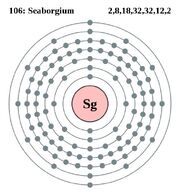
Seaborgium is a chemical element with the symbol Sg and atomic number 106. It is an element whose most stable isotope 271Sg has a half-life of 1.9 minutes. Chemistry experiments with seaborgium have firmly placed it in group 6 as a heavier homologue to tungsten. The Berkeley team suggested the name seaborgium (Sg) to honour the American chemist Glenn T. Seaborg credited as a member of the American group in recognition of his participation in the discovery of several other actinides. The name selected by the team became controversial. The IUPAC adopted unnilhexium (symbol Unh) as a temporary, systematic element name. In 1994 a committee of IUPAC recommended that element 106 be named rutherfordium and adopted a rule that no element can be named after a living person. This ruling was fiercely objected to by the American Chemical Society. Critics pointed out that a precedent had been set in the naming of einsteinium during Albert Einstein's life and a survey indicated that chemists were not concerned with the fact that Seaborg was still alive. In 1997, as part of a compromise involving elements 104 to 108, the name seaborgium for element 106 was recognized internationally.
Characteristics[]
Much seaborgium chemical behavior is predicted by extrapolation from its lighter cogeners molybdenum and tungsten. Molybdenum and tungsten readily form stable trioxides MO3, so seaborgium should form SgO3. The oxides MO3 are soluble in alkali with the formation of oxyanions, so seaborgium should form a seaborgate ion, SgO42−. In addition, WO3 reacts with acid, suggesting similar amphotericity for SgO3. Molybdenum oxide, MoO3, also reacts with moisture to form a hydroxide MoO2(OH)2, so SgO2(OH)2 is also feasible. The heavier homologues readily form the volatile, reactive hexahalides MX6 (X=Cl,F). Only tungsten forms the unstable hexabromide, WBr6. Therefore, the compounds SgF6 and SgCl6 are predicted, and "eka-tungsten character" may show itself in increased stability of the hexabromide, SgBr6. These halides are unstable to oxygen and moisture and readily form volatile oxyhalides, MOX4 and MO2X2. Therefore SgOX4 (X=F,Cl) and SgO2X2 (X=F,Cl) should be possible. In aqueous solution, a variety of anionic oxyfluoro-complexes are formed with fluoride ion, examples being MOF5− and MO3F33−. Similar seaborgium complexes are expected.
Value[]
The base value of each unit of ranges between 40 and 100Ð per unit, with up to 2 units being found at any one time.
Presence on Mars: Very Rare
| Martian Minerals | |
| Group 1 | Group 2 | Group 3 | Group 4 | Group 5 | Group 6 | |
| Group 5 | |Americium | Anthraximite | Areanetium Dieinsteinium | Areanetium Ferrocrete | Areanetium Mendelite | Berkelium | Bohrium | |Californium | Curium | Darmstadtium | Einsteinium | Fermium | Fermium Hasside | Ferro-plat Alloy | Hassium | Lawrencium | |Meitnerium | Meitnerium Golgathide | Mendelevium | Neptunium | Nobelium | Plutonium | Roentgenium | Seaborgium | |Transuranic Alloblast | |